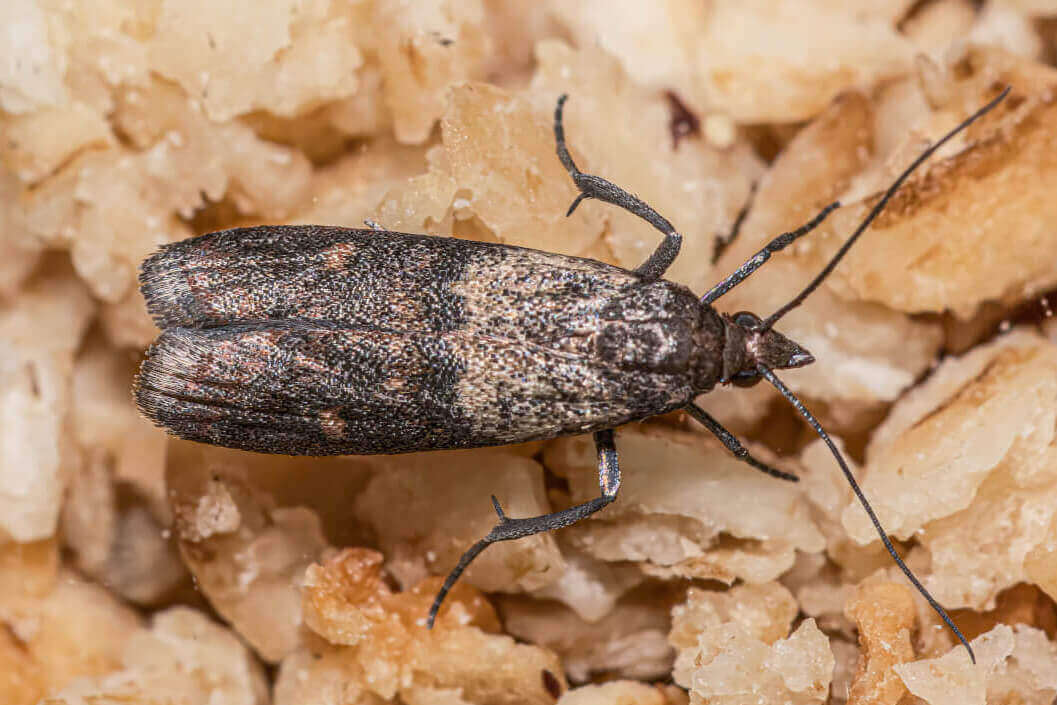Indian Meal Moth Facts & Information
Everything you need to know about Indian meal moths
what do Indian Meal Moths look like

The Indian meal moth is one of the most commonly reported pests of stored grains in the United States. Adult Indian meal moths are about 3/8 of an inch long and have a wingspan of about 5/8 of an inch. They have an elongated oval shaped body, their wings are gray in color except for the rear half which are a distinctive rusty bronze color. The head of the larva is dark brown in color. Moth extermination may be needed for a large infestation.
Larvae of the Indian meal moth feed upon grains, grain products, dried fruits, nuts, cereals, and a variety of processed food products. The Indian meal moth is also a common pantry pest. Adults can be seen resting on the grain surface or grain bin walls. The adults fly at night and are attracted to lights.
The eggs of the Indian meal moth are whitish, ovate and very small. Because of their small size, they are difficult to see without the aid of a microscope. Eggs are deposited on the grain surface singularly or in groups of twelve to thirty.
Newly hatched larvae are very small and difficult to see. Larger larvae are usually yellowish, greenish, or pinkish. Fully grown larvae are one-half to five-eights of an inch in length with a brownish head capsule. Larvae have three sets of legs near the head (thoracic legs) and five sets of prolegs on the abdomen. Larvae of the meal moth spin a web as they become fully grown and leave behind silken threads wherever they crawl. The webbing is often sufficiently abundant to attract attention. Loosely clinging webbing on the grain is characteristic of this pest.Not the moth you have?
Larvae of the Indian meal moth feed upon grains, grain products, dried fruits, nuts, cereals, and a variety of processed food products. The Indian meal moth is also a common pantry pest. Adults can be seen resting on the grain surface or grain bin walls. The adults fly at night and are attracted to lights.
The eggs of the Indian meal moth are whitish, ovate and very small. Because of their small size, they are difficult to see without the aid of a microscope. Eggs are deposited on the grain surface singularly or in groups of twelve to thirty.
Newly hatched larvae are very small and difficult to see. Larger larvae are usually yellowish, greenish, or pinkish. Fully grown larvae are one-half to five-eights of an inch in length with a brownish head capsule. Larvae have three sets of legs near the head (thoracic legs) and five sets of prolegs on the abdomen. Larvae of the meal moth spin a web as they become fully grown and leave behind silken threads wherever they crawl. The webbing is often sufficiently abundant to attract attention. Loosely clinging webbing on the grain is characteristic of this pest.Not the moth you have?
how did i get indian meal moths
You most likely got Indian meal moths from an infested package of food. As long as the temperature within a grain bin or building where grain is stored remains above 50° F, the Indian meal moth can survive and reproduce. A typical life cycle (egg to adult) is completed in forth to fifty-five days. A potential for seven to nine generations per year exists; however, because of cool temperatures during the winter months fewer generations are usually completed. Under optimal conditions, the entire life cycle can be completed in approximately twenty-eight days.
A mature female lays 100 to 300 eggs on food material, either singularly or in groups of twelve to thirty. Larvae begin to hatch in two to fourteen days, depending on environmental conditions. Newly hatched larvae feed on fine materials within the grain and are small enough to pass through a sixty mesh screen. For this reason, it is difficult to exclude larvae from most packaged foods and grain.
However, larvae cannot chew through packages, so they must enter through a hole or at the seam. The larval stage lasts from two weeks to one year, and is responsible for grain losses. In grain, larval feeding is usually restricted to the top one to two inches. Large larvae feed on the grain germ. When mature, larvae spin a silken cocoon and transform into light-brown pupae. The cocoons and pupae can be seen on the grain surface and walls of grain bins. Adults emerge in four to thirty days, mate, and females lay the next generation of eggs. Adults live from five to twenty-five days.
A mature female lays 100 to 300 eggs on food material, either singularly or in groups of twelve to thirty. Larvae begin to hatch in two to fourteen days, depending on environmental conditions. Newly hatched larvae feed on fine materials within the grain and are small enough to pass through a sixty mesh screen. For this reason, it is difficult to exclude larvae from most packaged foods and grain.
However, larvae cannot chew through packages, so they must enter through a hole or at the seam. The larval stage lasts from two weeks to one year, and is responsible for grain losses. In grain, larval feeding is usually restricted to the top one to two inches. Large larvae feed on the grain germ. When mature, larvae spin a silken cocoon and transform into light-brown pupae. The cocoons and pupae can be seen on the grain surface and walls of grain bins. Adults emerge in four to thirty days, mate, and females lay the next generation of eggs. Adults live from five to twenty-five days.
where do indian meal moths live
Stored-grains offer compact food sources for a number of insect pests. So, they will often head to grain silos. They will travel with the grain to food processing plants and can then infest other products in that plant. Once that happens, wherever the food is shipped, so will the Indian meal moths. Once the infected product is purchased, they are now in a home or business’s pantry. Good sanitation practices from the start of the Indian meal moth infestation will help keep them out in the first place.
what Problems do indian meal moths cause
Indianmeal moth larvae, even in small numbers, will damage food items by eating through them and spinning silk webs between damaged and undamaged particles of food. They are actually considered the most common stored-food pest because Indian meal moths feed on such a wide variety of dried food goods. The pests can sometimes be found inside packaged goods that you bring into your home or get delivered by a vendor to your business so it’s tough to keep in front of these pests. Larvae are sometimes seen crawling on walls and ceilings near sources of the infestation in a home. If you do see them or suspect an Indianmeal moth infestation, bring in a professional to provide moth treatments for ultimate Indianmeal moth control.
how can i prevent indian meal moths
The only way to control Indian meal moths is to locate infested materials and clean them out. A thorough cleaning is also needed to get rid of errant caterpillars, cocoons, and food sources. Preventing them can be difficult since they are more often than not brought in unknowingly in an infested package of food. Indian meal moth larvae feed on grain and stored food, not on fabric. So, make sure any uninfected foods in your pantry stay that way by keeping them in airtight containers. Adult Indian meal moths are attracted to light and may fly away from the pantry into bedrooms, where they can be mistaken for clothes moths. So, if you see moths, don’t assume what kind they are from where you are seeing them.
WHY WESTERN for indian meal moth control
We’re passionate about controlling moths in your home or business because we live and work here – it’s our neighborhood, too. With our almost 100 years of experience keeping homes and businesses in Connecticut, Delaware, New Jersey, New York, and Pennsylvania safe from pests, Western has the experience you can trust.
100% Satisfaction Guarantee
24-Hour Guaranteed Response
Board Certified Entomologists
Need help with Indian meal moths?
GET A QUOTE
“We installed your Termite Defensive a number of years ago and have not seen even one termite since the system was installed.”
Edison, NJ
